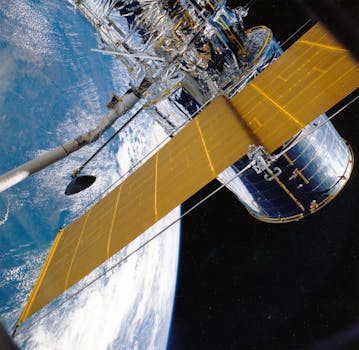
The Future is Now: Exploring the Cutting-Edge Innovations in Satellite Telecommunications
Satellite Telecommunications is undergoing a significant transformation, driven by technological advancements and increasing demand for global connectivity. The future is now, and it’s exciting to explore the cutting-edge innovations that are revolutionizing the industry. Satellite Telecommunications has become an essential part of modern life, enabling communication, navigation, and remote sensing. In this article, we will delve into the latest developments and their impact on the future of satellite telecommunications.
Advances in Satellite Technology

Recent years have seen significant improvements in satellite technology, including the development of smaller, more efficient, and cost-effective satellites. The introduction of Low Earth Orbit (LEO) satellites has enabled faster and more reliable communication, with lower latency and higher throughput. Additionally, the use of High Throughput Satellites (HTS) has increased the capacity of satellite communications, making it possible to support a wide range of applications, from broadband internet to mobile connectivity.
The development of phased array antennas has also enhanced the performance of satellite communications, allowing for more efficient use of bandwidth and improved signal quality. Furthermore, the integration of artificial intelligence (AI) and machine learning (ML) algorithms has enabled satellites to optimize their performance, predict and prevent errors, and improve overall system reliability.
Next-Generation Satellite Constellations

The launch of next-generation satellite constellations, such as OneWeb and Starlink, is set to revolutionize the satellite telecommunications industry. These constellations will provide global coverage, enabling ubiquitous connectivity and bridging the digital divide. With thousands of satellites in orbit, these constellations will offer unparalleled capacity, speed, and reliability, making them an attractive solution for a wide range of applications, from consumer broadband to enterprise networks.
The development of these constellations has also sparked innovation in areas such as satellite manufacturing and launch technology. The use of 3D printing and automation has enabled the rapid production of satellites, reducing costs and increasing efficiency. Additionally, the development of reusable launch vehicles has made it possible to launch multiple satellites into orbit at a lower cost, further reducing the barriers to entry for new players in the industry.
Impact on Global Connectivity

The cutting-edge innovations in satellite telecommunications are having a profound impact on global connectivity. With the ability to provide ubiquitous coverage, satellite constellations are enabling communication in remote and underserved areas, bridging the digital divide and fostering economic growth. The increased capacity and speed of satellite communications are also supporting a wide range of applications, from IoT and smart cities to telemedicine and distance learning.
The development of satellite telecommunications is also driving innovation in other industries, such as aviation and maritime. The use of satellite communications is enabling real-time monitoring and tracking, improving safety and efficiency in these industries. Furthermore, the integration of satellite communications with other technologies, such as 5G and edge computing, is creating new opportunities for innovation and growth.
Conclusion

In conclusion, the future of satellite telecommunications is now, and it’s exciting to explore the cutting-edge innovations that are revolutionizing the industry. From advances in satellite technology to the development of next-generation satellite constellations, the impact on global connectivity is profound. As the industry continues to evolve, we can expect to see even more innovative solutions, driving growth, and fostering economic development. The future is now, and it’s time to embrace the limitless possibilities of satellite telecommunications.
See more:







